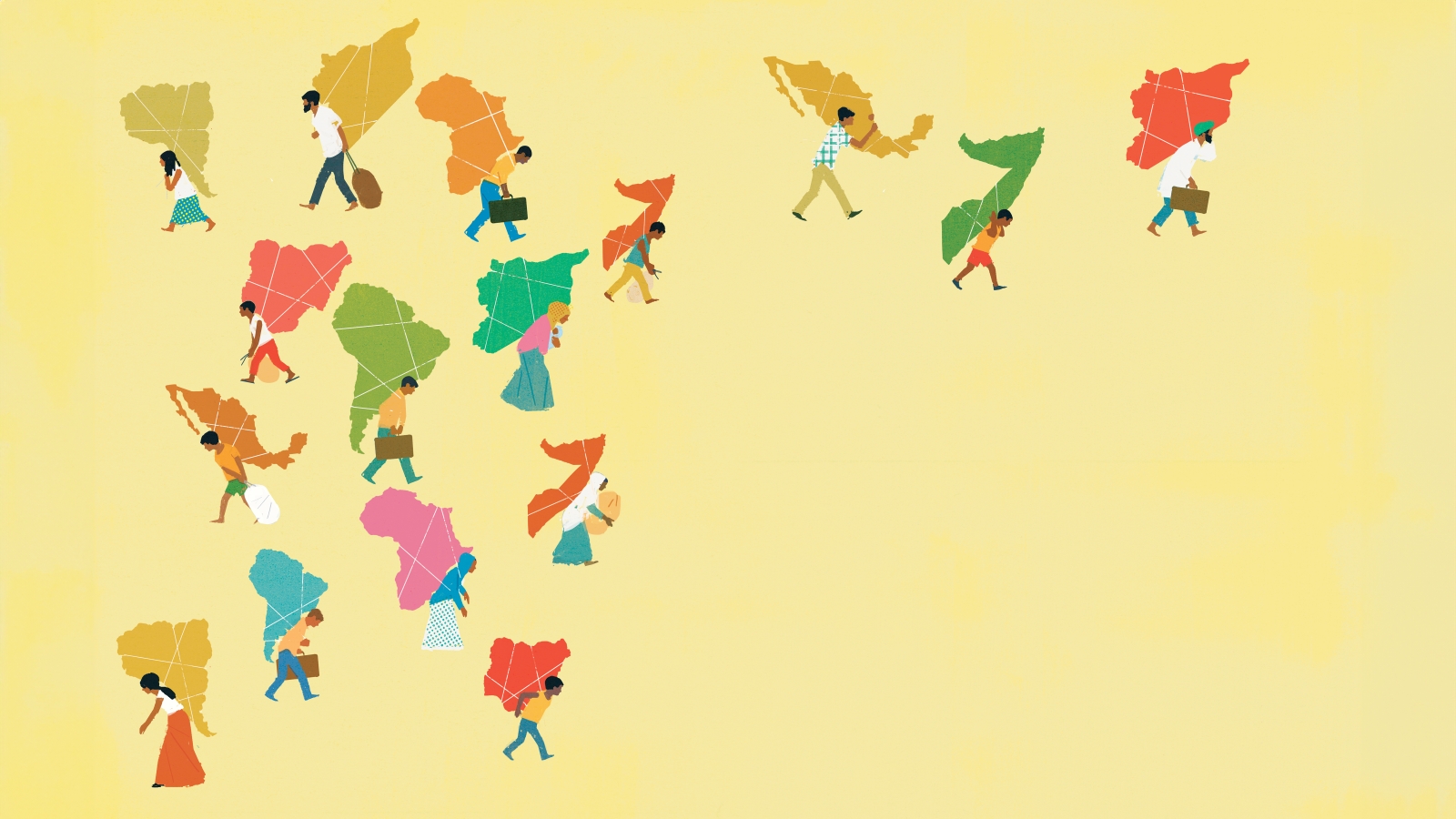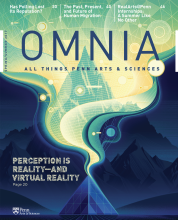Displacement. Poverty. Persecution. Economic opportunity. These are some of the many reasons that people migrate to countries thousands of miles from their ancestral homelands. In modern history, major demographic transitions have included the influx of immigrants to the U.S. from the mid-1800s to the early 20th century; the flow of humanity at the end of World War II, when tens of millions of people, particularly in Europe, were sundered from their native countries by years of violent conflict; and the movement of more than 17 million Africans within their continent in the 21st century. Today, more than 200 million people—most from Latin America, South Asia, and Africa—are migrants both within and across continents.
“Migration is now a big part of the global economy and of global society,” says Hans-Peter Kohler, Frederick J. Warren Professor of Demography and a Research Associate in the Population Studies Center.
Although migration is a complex story, many Americans and Europeans see it in simplistic terms, according to Tukufu Zuberi, Lasry Family Professor of Race Relations and Professor of Sociology and Africana Studies: There are “natives,” who belong, and “foreigners,” who do not. New cultures, languages, and economic demands of immigrants have roiled Western societies in the past decade, making migration a new locus of international concern.
To better understand the mass movement of populations across the globe, Penn social science faculty are interpreting data, analyzing the effect of immigration on sending and receiving countries, and untangling the many complexities of immigration today. Their work offers new perspectives on how mass migration shapes our world.
Unwelcoming Neighbors
When Zuberi studied the response of largely white Washington, D.C. neighborhoods to an influx of migrants, the results surprised him.
“When there is more diversity, whites are less tolerant of those of other races,” Zuberi said. “We used to think exactly the opposite. It made sense that the more diverse a city was, the less segregated it would be. That turns out not to be true.”
Zuberi, a demographer whose primary interest is in the African diaspora, published his findings in Sociology of Race and Ethnicity in 2015.
Putting the rise of segregation in D.C. into global context, Zuberi looks at larger social changes afoot in the U.S. and in Western Europe.
On a worldwide level, he explains, dramatic immigration shifts are going to create radical changes in the identity of populations. The influx of nonwhite groups into the U.S. and Europe—particularly the U.S., France, the U.K., and Germany—has whites there “singing an anti-immigrant note.”
“Whites have regarded themselves as a nation’s ‘first-class’ citizens, but immigration is increasingly challenging this view as nonwhite communities continue to grow,” Zuberi says.
Demographic studies show that the U.S. will become a “minority majority” population in the 21st century, meaning that nonwhites will comprise the majority of the U.S. population.
According to Zuberi, this is just the latest chapter in a long, and often violent, history of demographic shifts on the North American continent.
“White Europeans displaced the indigenous peoples here and also brought in a large group of enslaved individuals. And now whites are being displaced,” he said.
He sees the recent presidential election as “the reaction of white people to their own demographic demise,” and added, “Race is the problem in America and in the Western world now.”
Melding into Society
Michael Jones-Correa, Professor of Political Science, examines the opinions, behavior and policy preferences of Latino immigrants to the U.S. He served as co-principal investigator of the 2006 Latino National Survey, a national state-stratified survey of Latinos in the U.S.
Jones-Correa sees our era as the “end of consensus, both in the U.S. and Europe, that immigration is necessarily a good thing.” Immigration, he feels, was a central value to Western society, and it was a given that letting immigrants in was beneficial for the society and the economy—and that it enabled displaced families to reunify and rebuild their lives.
“I think all those principles are, at the very least, being questioned,” Jones-Correa says. He adds that in the U.S. and Europe, “[we] are seeing the rise of these openly anti-immigrant parties that are willing to pay fairly high costs—in the case of the U.K., actually pulling back out of the EU—in order to, as they would put it, regain control of their borders.”
More recently, he has been looking at “immigrants in the suburbs, specifically how suburban native-born Americans respond to immigration,” he says, and at relations among immigrants and the U.S.-born in Philadelphia and Atlanta.
Looking at individual communities can give a bigger picture of the relationships among white and African Americans and migrant groups. A lack of contact among individuals in neighborhoods and workplaces, for example, can lower U.S.-born residents’ tolerance for migrants and lead to support for policies like those hardening the border, restricting immigration into the U.S.
Yet, most Americans do not realize that there has been a net-zero flow of undocumented migration across the U.S. border from Mexico since 2008. And half of all those who are in the U.S. illegally are here because of visa overstays, not because they cross the border without papers.
“A lot of what building a physical wall would do is already accomplished,” says Jones-Correa. He adds that much of the border is already heavily fenced, except in the desert and mountains. This is where people cross over—and where the building of a wall would be, architecturally, a near impossibility.
“Addressing the situation of undocumented workers in ways other than deportation is a policy imperative not just for the undocumented workers themselves, but also for the United States, and the workers’ receiving communities.”
"Crimmigation"
The path to deportation can begin with a minor legal infraction. This is because Immigration and Customs Enforcement (ICE) relies on criminal justice agencies, such police and sheriff’s departments, to identify immigrants for deportation, no matter how minor the crime.
“Mundane violations, such as fishing without a license, running a stop sign while riding a bike, and driving with a broken taillight, have all resulted in undocumented immigrants’ arrest by local police and subsequent removal by federal authorities,” says Amada Armenta, Assistant Professor of Sociology.
In her forthcoming book, Protect, Serve, and Deport: The Rise of Policing as Immigration Enforcement, Armenta analyzes how local police are pivotal actors in the immigration enforcement system although they do not technically enforce immigration laws.
“We call this the ‘crimmigration system’ because it’s a blurring of the line between law enforcement and immigration enforcement,” Armenta says.
In her book, she focuses on the immigrant community in Nashville, Tennessee’s Davidson County. Between 2007 and 2012, the Davidson County Sheriff’s Office participated in an experimental immigration enforcement program called 287(g), which empowered the agency to enforce immigration laws. The sheriff’s employees became de facto immigration officers, screening arrestees for immigration violations. The result? Over 10,000 immigrants were identified for deportation by local authorities. The U.S. government scaled back the program in 2012 because it was deemed ineffective in identifying dangerous criminals for deportation.
“President Trump wants this program not only reinstated but expanded,” Armenta says.
The problem, in her view, is that the broadening of police powers to include deportation erodes the trust between police and the community they serve.
“I study how Latino immigrants perceive safety, and if they feel comfortable reporting crimes of victimization,” she says. “It’s important for the community to feel that they trust the police and vice versa.”
The Other One Percent
The image of the immigrant as a poor person from Mexico who lacks education stands in direct contrast to the reality of the second-largest group of immigrants to the U.S.: Asian Indians. The most educated and highest-income immigrants to the U.S., they began entering the country in number following the 1965 Immigration and Nationality Act (also known as the Hart-Celler Act).
“Seventy percent of Indian immigrants to the U.S. have professional degrees, in comparison to 20 percent of the American population,” says Devesh Kapur, Professor of Political Science, who is the Madan Lal Sobti Professor for the Study of Contemporary India and serves as Director of the Center for the Advanced Study of India.
In his new book, The Other One Percent: Indians in America, he examines the migratory journey of Indian immigrants as well as Americans of Indian descent. The book, co-authored with two of Kapur’s colleagues in the field, has been reviewed in such prestigious periodicals as The Economist and The Financial Times.
“If the U.S. is going to put a cap on migration into the country, what is the optimal mix of legal immigrants in terms of public policy? Those who are young and skilled and ‘fiscally attractive’? Those who are fleeing persecution and come in seeking asylum or as refugees fleeing wars and conflict? Those who are coming in as family reunification or family sponsorship?” Kapur asks. “These are contentious choices and pose difficult trade-offs—and those won’t be easy conversations,” he says.
A Bimodal Trend
Emilio Parrado, Dorothy Swaine Thomas Professor of Sociology, describes immigration to the U.S. as a “bimodal history.” Immigration was high at the end of the 19th and early 20th centuries, declined during the interwar period, and increased again in recent decades. The bimodal trend presents two different images of the U.S.
Chair of the Department of Sociology, Parrado does research focusing on migration, both within and across countries, as a significant life-course event with diverse implications for the migrants themselves, for their families, and for the sending and receiving areas and countries.
“What is it that we look at when we evaluate immigration today?” he asks. “Is it really high, out of control immigration, or is it just back to a more normal level after a decline that ended primarily in the 1980s?” He added, “If we were so successful at incorporating immigrants before, why is Mexican immigration perceived as a burgeoning threat?”
There are two critical issues to consider when discussing immigration from Latin America to the U.S., he explains. The first is the flow of immigrants, the number of people coming in and out of the U.S.; the second is what is called the immigrant “stock,” the foreign-born population residing in the U.S.
We make a “rigid distinction between immigrants and Americans, and between immigrants and U.S. residents, and that distinction is not as clear as one might think,” Parrado explains.
For example, what is the rightful status of children brought into the U.S. as infants, the “DREAMers,” children who have little connection with Mexico as their homeland? The only difference that separates them from U.S. citizens is place of birth, Parrado says. Moreover, as a group they have been very successful at completing high school, attending college, and securing employment.
Deporting them would be not only a terrible outcome for the immigrants themselves, but also a loss of significant human capital for the U.S., Parrado argues.
But the problem is not only for DREAMers. “Addressing the situation of undocumented workers in ways other than deportation is a policy imperative not just for the undocumented workers themselves, but also for the U.S. and the workers’ receiving communities,” he says.
Parrado claims that the revitalization of local areas and cities depends on a dynamic immigrant population. He calls it “disheartening” to see what is happening to the children of immigrants in the U.S. when they and their families are threatened with deportation. He points out that many of those being forced out of the country are the spouses, parents, and children of U.S. citizens.
“Do we really want to tear apart the families of U.S. citizens because we don’t want to regularize the situation of foreign-born workers?” he asks.









